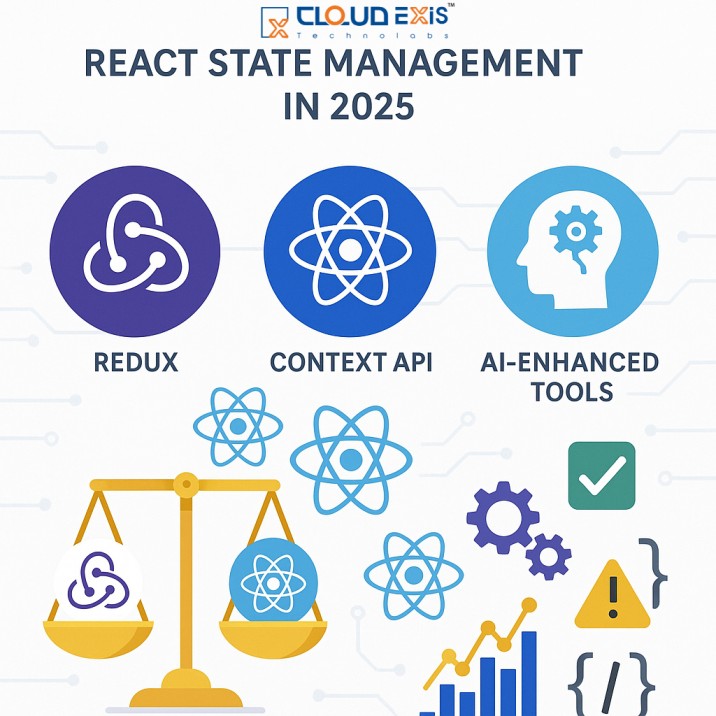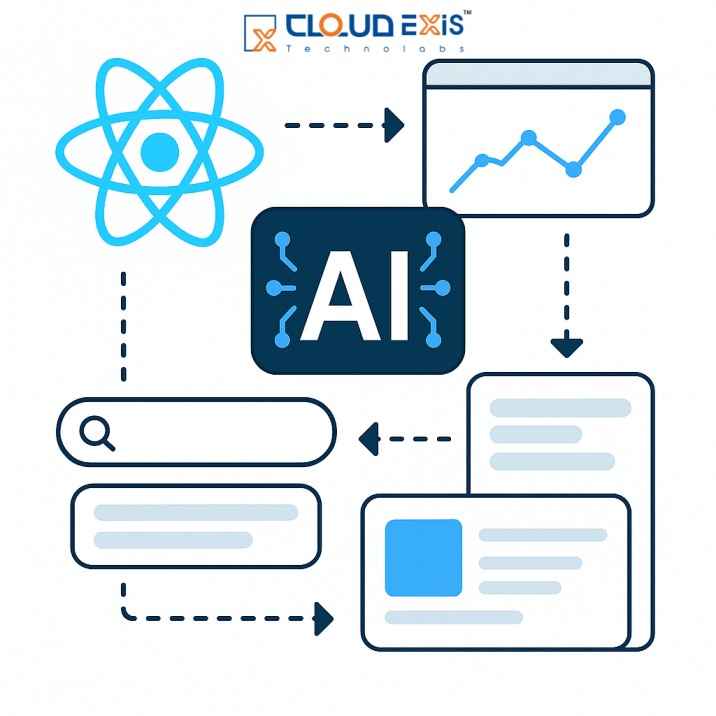Introduction
React has always been one of the most powerful frameworks for building dynamic, interactive web applications. But as every React developer knows, state management is both its superpower and its biggest challenge. Over the years, developers have relied on different solutions from the heavyweight Redux, to the built-in Context API, to an emerging wave of AI-enhanced tools that promise smarter, automated state handling.
As we step into 2025, state management in React isn’t just about “where to store data” anymore, it’s about scalability, performance, developer experience, and AI-driven automation. In this blog, we’ll break down the current landscape and help you choose the right solution for your projects.
The Evolution of React State Management
Before we dive into the 2025 showdown, let’s quickly recap the journey:
2013–2016: React setState & Props Era
Developers relied heavily on local component states (useState,setState) and prop drilling. It worked for small apps but quickly became messy in larger ones.2016–2018: Redux Dominance
Redux became the go-to solution for managing global state with predictable flows. Its strict architecture (actions, reducers, stores) was a lifesaver for big teams but also introduced a lot of boilerplate.2018–2020: Context API Matures
With React’s Context API and Hooks, developers had a built-in alternative to Redux. It reduced boilerplate and simplified state sharing, but performance issues (like unnecessary re-renders) made it tricky for larger apps.2021–2023: Rise of Alternative Libraries
Tools like MobX, Recoil, Zustand, and Jotai gave developers more options. These libraries promised less boilerplate, easier setup, and more flexibility.2024–2025: AI Enters the Picture
With the integration of AI-powered developer tools (like GitHub Copilot, OpenAI API integrations, and specialized AI React plugins), developers can now auto-generate state logic, optimize reducers, and even detect memory leaks or re-render bottlenecks.
Option 1: Redux in 2025 – Still Relevant?
For nearly a decade, Redux has been the king of state management. But is it still worth using in 2025? Let’s break it down.
Strengths of Redux Today:
Predictability – The unidirectional data flow (dispatch → reducer → new state) makes debugging easy.
Ecosystem – Redux Toolkit (RTK) has reduced boilerplate and comes with built-in support for asynchronous logic, API queries, and TypeScript.
Scalability – Still one of the best options for very large, enterprise-level applications.
Tooling – Redux DevTools remain a gold standard for debugging state changes.
Limitations in 2025:
Complexity – Even with Redux Toolkit, managing actions, reducers, and middleware can feel heavy compared to simpler alternatives.
Learning Curve – Junior developers often struggle with Redux’s concepts.
Overkill for Small Apps – For smaller React apps, Redux is often unnecessary.
Verdict: Redux is still relevant for large-scale apps with complex state logic and multiple developers. But it’s no longer the default choice.
Option 2: React Context API in 2025 – Built-In and Lightweight
The React Context API has steadily improved, and in 2025, it’s more powerful than ever. It’s the go-to solution for small to medium apps or when you just need to share global state (like themes, user authentication, or app settings).
Strengths of Context API:
No Extra Library Needed – It’s built into React (currently React 19).
Simple API – With
createContextanduseContext, setup is fast and intuitive.Great for Small Apps – Perfect for handling light global state without overhead.
Limitations in 2025:
Performance Issues – Context can still cause unnecessary re-renders when state updates frequently.
Not Ideal for Complex State – Handling async operations, API caching, or deeply nested state can become messy.
Debugging Tools Limited – Unlike Redux, Context lacks strong ecosystem tools.
Verdict: The Context API is excellent for lightweight state sharing but struggles at an enterprise scale.
Option 3: AI-Enhanced State Management – The New Frontier
Here’s where things get exciting. AI React development in 2025 is no longer just about autocompleting code, it’s about optimizing your entire state management process.
AI tools are being integrated into IDEs, CI/CD pipelines, and even runtime environments. For state management, AI can:
How AI Helps State Management:
Automatic Boilerplate Generation
AI can scaffold Redux reducers, Context providers, or Zustand stores based on your app’s data flow.Performance Optimization
AI-powered linting tools can detect unnecessary re-renders, suggest memoization, and even auto-optimize component trees.Predictive State Flows
Using app usage patterns, AI can suggest pre-fetching or caching strategies to enhance the user experience.Bug Prevention
AI can highlight potential race conditions, unhandled async logic, or memory leaks before they hit production.Hybrid Approaches
Some AI-driven libraries (experimental in 2025) manage state dynamically, switching between local state, context, or persistent storage depending on usage.
Example AI-Enhanced Tools in 2025:
Vercel AI State Manager (Beta) – Predicts and optimizes global vs local state automatically.
Copilot for Redux – Auto-generates reducers and async thunks.
AI-Powered Recoil Extensions – Suggests atom splitting or merging for optimal performance.
Verdict: AI-enhanced tools are not replacing Redux or Context yet, but they’re augmenting developers’ productivity and reducing repetitive work. Early adopters are already seeing faster development cycles and fewer bugs.
Redux vs Context vs AI – A 2025 Comparison
| Feature | Redux | Context API | AI-Enhanced Tools |
|---|---|---|---|
| Complexity | High (even with RTK) | Low | Low (AI handles boilerplate) |
| Best For | Enterprise apps | Small-medium apps | Any app (productivity boost) |
| Performance | Excellent with optimization | Risk of re-renders | AI suggests improvements |
| Ecosystem | Mature & robust | Limited | Rapidly growing |
| Debugging | Strong DevTools | Weak | AI-assisted debugging |
| Learning Curve | Steep | Easy | Easy (AI assists setup) |
When to Use Each in 2025
Use Redux if:
You’re building a large, enterprise-level app.
You need a strict, predictable state flow.
You want powerful debugging tools.
Use Context API if:
You’re building a small to medium React app.
You need to share lightweight state (auth, theme, settings).
You want simplicity without external libraries.
Use AI-Enhanced Tools if:
You want to speed up development with AI boilerplate generation.
You’re building apps with frequent state updates and want automatic optimization.
You’re open to early adoption of emerging AI frameworks that improve with usage.
Future of React State Management
By 2025, the question isn’t Redux or Context API anymore. It’s how much AI will change the way we manage the state. Developers are increasingly combining these approaches:
Redux + AI → Best for large apps where AI reduces boilerplate.
Context + AI → Perfect for smaller apps where AI auto-optimizes and re-renders.
Hybrid State Management → Expect libraries that seamlessly blend Redux, Context, and AI logic in the next few years.
Final Thoughts
React state management in 2025 isn’t about choosing a single winner. Redux, Context API, and AI tools all have their place.
Redux remains the heavyweight champion for enterprise-scale apps.
Context API is the lightweight built-in option for small to mid-sized projects.
AI-enhanced tools are the rising star, reshaping how developers build and optimize apps.
The best strategy? Contact Us. Stay flexible. Use the right tool for your project’s size and complexity, and don’t hesitate to embrace AI assistance. The future of React development is about building smarter, faster, and with fewer bugs and AI is becoming the secret weapon.






